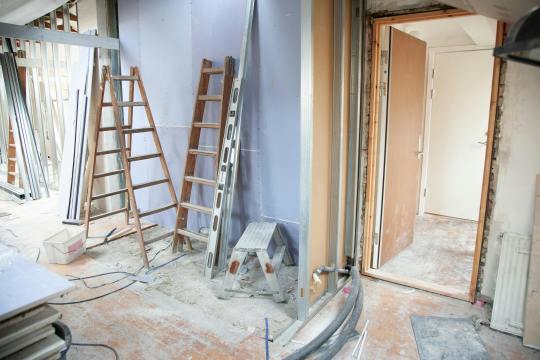Douglas A.G. “Doug” Stevenson is a longtime Carlisle, MA resident who has a passion for the outdoors and an extensive track record in the construction industry. With his current consulting enterprise RBS Limited LLC, Doug Stevenson delivers a range of construction management services, while acting as a homeowner's representative. Among his project-specific offerings are customer relations management and sales and marketing oversight. Beyond the construction industry, Mr. Stevenson has extensive leadership experience with the Boy Scouts of America. He progressed through the ranks as a Scout, and as a parent he served as committee chair of the Carlisle, MA Cub Scout Pack. A Life Scout, he has been inducted as a member of the Order of the Arrow. Serving as a Scoutmaster, he has also presided at many Eagle Scout ceremonies over the years. A Boston College graduate, Mr. Stevenson obtained his bachelor’s degree in physics in 1981. Fitness focused, he has competed in a dozen marathons over the years and competed in the Boston Marathon in 2015. Also a lifelong sailor. Douglas A.G. Stevenson has owned a Laser II sailboat and raced as a member of the Hickory Hills Sailing Club.
Don't wanna be here? Send us removal request.
Text
Doug Stevenson Recognized with a 2009 Community Service Award

Doug Stevenson, RBS Limited President and a former Boy Scout, was awarded the 2009 Community Service Award from the Middlesex West Chamber of Commerce. During the Chamber of Commerce Annual Awards Dinner, Mr. Stevenson was recognized for his outstanding role in decades of community service in Carlisle. The award recognized his dedication, commitment, and loyalty to serving his community, which earned him respect and admiration. For many years, Doug Stevenson has placed over 250 American flags on the graves of veterans, a personal commitment he has continued with his wife and three children.
At the time of the award, Doug Stevenson had served as a member of the Carlisle on-call Fire Department for 27 years and had served on the board of Selectmen for 11 years, including being elected four terms as the chairman. Other positions Mr. Stevenson has held include Chairman of the Veterans’ Honor Roll Committee and a member of numerous committees, including Recreation Committee, Christmas on the Common Committee, Old Home Day Committee, and Celebrations Committee. He is also a member of the Masonic Corinthian Lodge. He has served on several subcommittees, including the Land Preservation Committee, School Committee Liaison, Town Council Search Committee, and FinCom Team.
0 notes
Text
Cub Scouts Nurturing Critical Life Skills and Values

Boy Scouts of America helps to equip young people with ethical and moral values to guide them throughout their lives. In line with its mission, Boy Scouts of America has various programs, including the Cub Scouts Program, which helps youths acquire skills in leadership, citizenship, and personal fitness by conducting fun activities that include parents and guardians. Cub scouting covers youths in K-5th grade. The program entails scouting families, joining activities such as exploring the outdoors and building projects to make friends, as well as encouraging Cub Scouts to nurture their learning skills and allow them to earn patches corresponding to their grades.
Cub scouts meet once per week or twice a month, depending on the schedules of participating families. Parents and legal guardians of Cub Scouts work closely to ensure the success of the Cub Scouts program, which is achieved through initiatives such as mentoring, local in-person coaching, and national online training resources. Thanks to Cub Scouting, youths have a safe space to mingle, make new friends, and challenge themselves by participating in age-appropriate activities. The Cub Scouts Program helps children and families enjoy a sense of belonging that consistently boosts core values such as honesty, respect for others, and good conduct.
0 notes
Text
Key Considerations for Successful Residential Construction Projects

Residential construction requires detailed planning and precise execution. It could involve a person’s dream home or renovating an existing space, so it’s important to consider the fundamental factors that may impact the project for success.
Before beginning a residential construction project, it’s necessary to first establish a realistic budget. This helps to define the scope of the project, quality of materials, and professionals to hire. It’s also important to anticipate potential unplanned costs such as permits, labor, materials, and unplanned expenses which may arise in every phase of construction, so it’s advisable to have a contingency fund of around 10 to 20 percent of the entire budget to cover unforeseen costs.
A clear vision of the project's goals is also important, including the number of rooms, architectural style, and features such as energy efficiency or smart home technology. Communicating this vision with a mood board or collection of images can help architects and builders align with expectations.
Other critical steps include selecting the site location (which can influence the design and layout of the building, and its future value), hiring a team of qualified building professionals, factoring in zoning laws and building codes, selecting proper materials, and planning for long-term environmental and energy sustainability.
0 notes
Text
Key Factors to Consider When Renovating an Older Building

Years of use can take a toll on a building. Besides the constant exposure of the elements, wear and tear from tenant use can limit the attractiveness of commercial or residential buildings, along with the possible rents generated. Changing local codes and advances in energy efficiency may also diminish a property's appeal or functionality, making renovation a viable option.
Renovation involves a cosmetic update of the building with the objective of restoring the building to a functional and aesthetically attractive state (sometimes to its original one). A property owner may opt for renovation because it’s relatively minor and quick, requiring minimal architectural input, if any. In addition, renovation is ideal for preserving historically significant buildings, as it involves fewer approvals and permits. It also costs less than rebuilding an existing property.
However, renovation may not fully address modern building code requirements or capitalize on new energy efficient innovations. It may also fail to address long-term structural needs.
For commercial, residential, or multi-family buildings, renovations can effectively tackle critical issues with minimal disruption. This approach is particularly well-suited to historically significant structures, increasing the likelihood of approval from local authorities while preserving the building’s character.
0 notes
Text
The Mayflower Society Restores the Pilgrim Memorial Meetinghouse

The National Pilgrim Memorial Meetinghouse at the center of Town Square in Plymouth, Massachusetts, formerly known as the First Parish Church of Plymouth, was selected by The Mayflower Society for renovation and maintenance. The Mayflower Society, whose members all trace their roots back to at least one passenger who was on the Mayflower (a ship that transported English families from England to Plymouth) in 1620, took over the historic landmark in 2017. The goal of the project was to preserve and restore the building, with plans to transform it into an education and visitation center. Work formally began in 2019, but was soon interrupted by the COVID pandemic, which slowed fundraising efforts and the work itself.
Despite the challenges, the project resumed and work was classified into multiple phases. Phase One involved the successful installation of a new elevator, with Phase Two covering the construction of a new entrance on the building’s south side. After completion of structural work, the visitor experience will be enhanced with an IMAX movie theater, where guests will experience what it was like to be a passenger on the Mayflower. The building is expected to be a popular attraction for tourists visiting Plymouth, and help them learn more about the experience of the Mayflower passengers.
In the second phase of restoration, a 10 bell chime will be restored by the Verdin Company of Cincinnati, Ohio. Verdin’s team is expected to repair and restore the bells, bell pads, hardware, wood frame, and chimes (wood, metal, and leather parts). The Mayflower Meetinghouse bells were installed in 1921 and due to the passage of time, the hardware rusted and corroded due to its proximity to the ocean. After the estimated six-month project is completed, the chimes will play over 200 songs.
0 notes
Text
Addressing Hairline Cracks in Walls

Cracks can develop in walls in older structures and emerge at any time, including in walls built from drywall, concrete, plaster, stucco, or brick. Construction professionals categorize fissures measuring 1/10 of an inch wide or smaller as hairline cracks and superficial. These fine cracks occur as residences move, settle, contract, and expand with temperature changes.
Some homeowners try to use all-purpose filler to fill hairline cracks, but painting over the top is insufficient, as they reappear in days or weeks. Instead, use a Stanley knife to dig out the crack, making it wider. This creates space for inserting a flexible filler that buffers wall movements in a way that the inflexible original material could not when it fractured.
After widening the hairline crack a few millimeters and cleaning out loose debris, inject a quality product such as Toupret Fill Flex into the crevice with a caulk gun. Once completely dried, sandpaper the wall area with a medium grit product. After using a damp cloth to clean the surface, apply a fine surface filler with a filler knife. It fills in any remaining gaps and makes the finish smooth and sturdy. After drying, the repaired crack is ready for a layer of paint.
0 notes
Text
Fixing Hinge Issues in Home Cabinetry

Cabinet doors experience frequent use in kitchens and bathrooms. This use can lead to mechanical issues, such as becoming stuck or not closing completely, which require prompt attention.
Many times, cabinet hinges loosen over time. To fix it, push on the bottom of the cabinet doors and see if they move up. If they do, take a screwdriver to the hinges and tighten them. Individuals can adjust most hinges in three directions: up/down, left/right, and closer to/ further from the cabinet box. Open and close the door repeatedly with each tightening until achieving the optimal calibration to ensure a stable, smooth closing.
If the screw moves very freely in its socket, the hinge's hole has become damaged. Thus, individuals should relocate the stripped screws. It involves changing the hinge location relative to the cabinetry and wall. While it does result in multiple unused holes, individuals can fill the extra ones with quality filler, sand, and paint. Reinforcing the stripped hole with wood glue also provides a temporary solution.
0 notes
Text
Hiking to the Summit of Mount Washington in New Hampshire

Many New Hampshire hikers and climbers aim to summit the state’s 4,000-foot-plus mountains, such as the Northeast’s highest peak, Mount Washington. It encompasses a 60.3-acre state park, and an expansive 750,000-acre White Mountain National Forest surrounds it. The 6,288-foot high summit provides panoramic views extending as far as Vermont, Maine, Quebec, and the Atlantic Ocean.
The easiest approach to Mount Washington’s summit is from the west using the Jewell Trail, which starts at the Marshfield Base Station parking lot. There, passengers embark on the first mountain-climbing cog railway ever built, some 150 years ago. With an average grade of 25 percent and maxing out at 38 percent, the railway runs on powerful, custom-designed biodiesel locomotives. In addition, visitors may see a pair of legacy working coal-fired steam engines, with all train components maintained on-site.
Hikers eschew this convenient option and traverse a trail that gains a relatively moderate 4,000 feet of elevation across 5.2 miles. One distinct feature of this well-trafficked route is giant steps that cut through granite boulders across much of the section above the tree line. Hikers get a close-up glimpse of the cog railroad train at several points as it chugs up the mountain.
The shortest routes approach the summit along a ravine from the east. The Tuckerman Ravine Trail and Lion Head Trail start at Pinkham Notch and measure 4.2 miles one way. With the Tuckerman Ravine Trail more strenuous, it also provides better views, and some hikers create a loop using the two trails, tackling Tuckerman on the descent.
The 5.4-mile Boott Spur Trail is similar in orientation to the Tuckerman Ravine and Lion Head Trails but traverses the other side of the ravine. It breaks through treeline sooner than its counterparts, thus offering more extended views. It is also less traveled and ideal for those in search of solitude.
However, the Great Gulf Trail serves as the most challenging approach to Mount Washington. It starts off Route 16 at the Great Gulf Wilderness parking area. Clocking in at 7.4 miles one way, most embark on two-day wilderness backpacking excursions since they can access designated backcountry campsites. The trail follows the Peabody River for its initial section, sometimes hugging it tightly and others meandering uphill through the forest.
After around 2.5 miles, hikers reach The Bluff, which offers a dramatic view of the looming mountains. It appears as a semicircular wall, like a stage set. Beyond the bluff, hikers traverse a suspension bridge across the West Branch and surmount slippery wet ledges alongside rushing cascades, including Weetamoo Cascade.
At the 6.5-mile mark, hikers arrive at a small, picturesque mountain tarn. Spaulding Lake sits at the head of the glacially carved, amphitheater-shaped Great Gulf valley. Above it rises the rocky headwall, with hikers ascending 1,600 feet in under a mile. This steep section requires careful attention, as snow may wash away the trail markings and cause unstable footing.
From the top of the headwall, hikers ascend the last 0.4 miles using the Gulfside Trail and Trinity Heights Connector. The summit features the historic stone Tip Top House, constructed in 1853 as a hotel that remains closed to the public during renovations.
0 notes
Text
Crucial Skills in Construction Management

Construction management ensures projects are completed on time, within the budget, and achieving their goals. To achieve this, construction managers require precise skills and the ability to understand the processes and regulations affecting the sector and specific projects.
Industry knowledge is crucial to success in construction projects. Top managers possess specialized skills and are committed to continuous learning, which enhances their understanding of each project. Staying informed about sector developments—such as new technologies, innovations, and regulations, including building codes, zoning laws, and safety standards—is essential. Managers with exceptional proficiency and extensive industry knowledge often command premium salaries and attract global opportunities.
Equally crucial are leadership and management competencies. Construction managers must coordinate with professionals at various levels, from contractors, engineers, consultants, and senior management. This coordination requires an understanding of team dynamics for better management. Leadership, on the other hand, involves inspiring and motivating teams to excel. As a leader, а construction manager will leverage their collaborative skills to work with involved parties, like suppliers, government officials, and neighborhood association representatives, to ensure project success.
Strategic planning ability helps construction managers keep projects on track and enhance productivity. Financial management, a critical component of strategic planning, entails forecasting total project costs, developing a budget, and creating strategies to ensure projects remain within financial limits. Similarly, experienced construction managers accurately forecast material needs, coordinate with suppliers for timely deliveries, and avoid getting surplus materials to minimize waste and costs. Planning also extends to scheduling construction phases, optimizing resource use, and managing change orders efficiently.
Even with a solid plan and skilled teams, a project can fail without good communication. Industry studies indicate poor communication contributes to approximately half of project failures. As the central point of contact, construction managers should ensure clear communication with parties—from junior staff to top executives—keeping everyone aligned and enabling each group or individual to fulfill their role with minimal frustration. Good communication also goes beyond face-to-face interactions; it includes proficiency in online and written communication and using file-sharing platforms to enhance team coordination and track progress.
Strong communication skills also manifest in a construction manager’s ability to negotiate well. Given the various stakeholders they interact with, managers need to convince investors and developers of project feasibility, required budgets, and resources backed by solid data. With vendors or suppliers, construction managers negotiate pricing, delivery terms, and quality terms. Likewise, they negotiate with contractors about project scope, labor costs, and change orders. To have successful negotiations, experienced managers cultivate persuasive communication techniques, active listening skills, and emotional intelligence.
Construction management also demands a strong ability to identify, assess, and mitigate risks. On the construction site, this manifests as comprehensive knowledge of common hazards and implementation of safety protocols to safeguard workers and assets. Besides physical risks, experienced managers plan for potential disruptions, e.g., supply chain issues or client-driven specification changes. Whatever the case, construction managers should anticipate possible risks and develop contingency plans to ensure the project continues smoothly.
To succeed, construction managers should value and be receptive to feedback. Field workers often observe critical aspects of the construction process that can significantly impact the project’s outcome. Their insights—from on-site challenges to suggestions for improvement—can enable timely adjustments that contribute to overall success. To leverage this valuable input, managers should create an environment of psychological safety that encourages open communication. They can achieve this by reinforcing an open-door policy through both words and actions, providing anonymity if needed, and addressing raised concerns with an effort to understand different perspectives.
0 notes
Text
A Brick Schoolhouse - A Place of Warmth in a Time of Austerity

A grand master, Paul Revere chartered the Corinthian Lodge in 1797. However, the Masonic order did not have its first meeting place, a brick schoolhouse, until 1820. The order and that of the little brick building that served as a place for members to convene provide an exciting glimpse into the country’s history.
Before the American Revolution, settlers enjoyed the freedoms, abundant opportunities, and beauty of the pristine, undeveloped landscape. As the enthusiasm, excitement, and revelry of freeing the country from the English crown rose, patriots, many of whom were freemasons, fellowshipped as brothers in various locations. Boston was home to a few of these lodges, including Concord. By the spring of 1775, colonists hid military supplies at a location in Concord, the place where the Revolution began.
After receiving its independence, freemasons influenced the political and legislative direction of the country. Meeting places popped up throughout the country. Freemasons met, fellowshipped, and exchanged ideas in these places, including Concord’s Corinthian Lodge. The lodge was the 26th instituted by the Grand Master in Massachusetts on July 5, 1797, in the Concord Court House; all members had their petitions in hand. This meeting was in a building across from the Colonial Inn, an establishment built in 1716 and one that still exists. Grand Master Paul Revere stayed at the inn for meetings when he came into town, traveling 20 miles from Boston to Concord.
Establishing a government while also pioneering westward was challenging for the new Americans, with the citizens of the new country living in austere existences. However, the Corinthian Lodge meeting place provided members who routinely met a warm place where the men could engage in political talk, converse on business, or enjoy a good laugh among friends.
While they always convened, the locations changed. For the first 22 years of the organization’s charter, they met in six halls, the first being Joshua Jones’ Tavern on Exchange Street. The meetings were at the County House for the last three years. By November 1820, the brotherhood had a permanent place to meet. Concord had built a brick building, which the town and the Corinthian Lodge dedicated. The tower was to be the masonic meeting location, and a schoolhouse was where a young Henry David Thoreau reportedly taught school. With a permanent place to meet, the brothers reconvened at the building when the full moon hung in the sky, essentially becoming a moon lodge until 1916. The reason for becoming a moon lodge was that it provided members with enough light when there was no electricity, enabling members to travel on foot and horseback at night.
Several notable masons served at this lodge, which was the location of at least one historical event. Benjamin Hurd, for whom the Distinguished Service Medal of Royal Arch Masonry was named, had a son, Dr. Isaac Hurd, who served as the first lodge master. Dr. Hurd later became Senior Grand Warden. After him, Dr. Lemuel Shattuck served as the person after whom Boston Hospital was named. Author of masonic histories, Louis A. Surette, was also a master. Finally, the inventor of the Concord grape, Ephraim W. Bull, was also a master at one time. In addition to these notable people, the Masonic Lodge commemorated the location of the “first shot heard around the world” by laying a monument cornerstone in 1825. The first shot references a shot that was the inception of the Battles of Lexington and Concord.
0 notes
Text
Sustainable Trends in Home Renovations and Building

Sustainable and eco-friendly approaches to renovating and building houses have gained popularity in recent years. Lately, the focus has been on low-flow fixtures, water-efficient appliances, and tankless water heaters as sustainable, eco-friendly features. In addition to upgrading their appliances, homeowners integrate sustainability into their building projects.
Renovation projects in 2024 also emphasize using recycled materials and reducing waste as a part of home improvement projects. Using reclaimed wood has been one approach to decreasing reliance on wood from trees, minimizing deforestation. Not only are homeowners focusing on the materials used, but they are also shopping locally, choosing locally sourced materials and contractors. Going with local materials and contractors reduces the carbon footprint that transportation and traveling contribute to.
In 2024, homeowners are redesigning their places to be minimalist and multifunctional. Simplicity and function are the order of the day for many homeowners who seek to get most of the space they have because, in some cases, they do not have much space. For example, minimalism and multifunctionality work great for homes in urban places.
Homeowners and the designers helping them might create innovative layouts that allow a desk to transform into a bed or a kitchen island that can also function as a dining table. These innovative tricks that minimize space and maximize function also de-clutter space. Again, these spaces offer homeowners a harmonious, efficient experience that does not limit them on style or comfort.
Homeowners are also embracing natural light and biophilic designs. Skylights and large windows have become popular features that enable homeowners to bring more light into their homes. These fixtures radiate large amounts of light in interiors during the day, minimizing reliance on artificial light and reducing electricity costs. Besides relying on renovations that allow more light into the home, adding natural elements to the house, such as indoor plants, green walls, and stone and other natural materials, has been another trend in home renovations. By integrating natural lighting and materials, homeowners have created spaces that are not only environmentally friendly but also harmonious with nature.
Outside of simple renovations, homeowners use alternative methods for building their homes. For instance, one trend is to exchange the typical single-family home for a home created out of shipping containers. Yes, the exact shipping containers seen in any of the country's ports have become a staple material in housing. Usually, these containers are discarded after use, but using them as the house's structure is a chance for these metals to upcycle them. These homes are constructed from shipping containers combined to create a home's skeleton.
Outside of being a way to reuse material, using shipping containers saves contractors time because they provide the home with structure, something the builder would have to do. Plus, these containers can sit next to each other or be placed on top to save space, and aluminum and steel are durable materials.
Modular construction is another approach to building a home that offers sustainability and eco-friendliness. This method of homebuilding builds part of the home offsite and then assembles these parts at the house's location. Usually, the roof, the home's trusses (beams connected by nodes), or framed wall pieces are built elsewhere and connected to the house. One of the positive aspects of modular construction where sustainability is concerned is that it minimizes consumption. Offsite construction enables builders to use the best equipment to construct pieces, requiring less labor and reducing the amount of waste generated. With a more efficient building method, builders reduce timelines, contribute to a decreased carbon footprint, and reduce costs.
0 notes
Text
Scouting America Campaigns in Washington to Show Program Relevance

In July 2024 Scouting America, formerly the Boy Scouts of America, headed to Washington, D.C., to meet with legislators and discuss its relevancy and impact on communities. Known for imparting noble values and survival skills, Scouting America believes it remains "relevant and beneficial in a technology-driven, fast-paced world.”
Scouting America aims to prepare its members to positively impact their world through purpose. The organization's character development and values-based leadership program focuses on preparing members for life. Since its launch in 1910, it has helped over 130 million boys and girls.
The Washington, D.C. visit allowed Scouting America to illustrate the fun its members have while participating in its programs. The Cub Scouts of Pack 98 of the National Capitol Area set up a Pinewood Derby racetrack and cars for legislators to race in, with NASA astronaut and recipient of the Distinguished Eagle Scout Award Mike Fossum challenging Cub Scouts to a race.
The meeting came when many have questioned the benefits of Scouting America. Research shows that the skills members obtain provide numerous benefits, even with today’s media and tech distractions. A study by University of Edinburgh researchers reported that participating in scouting has lifelong positive impacts on health.
In a longitudinal study that tracked former scouts from the 1950s, researchers found that, by the 1990s, the adults rated their health as excellent because skills learned with the scouts, such as teamwork, confidence, and leadership were transferable to their work life as adults, which ultimately translated into health benefits. This has lasting cost-savings benefits in that societies that support youth programs such as scouting might see such programs as an aid to improving health population-wide without extra costs. In a more recent study, in 2015, Tufts University researchers surveyed 1,800 Cub Scouts and 400 non-scouting children to see if scouting impacted these children. They found that Cub Scouts reported feeling significantly more cheerful, kind, helpful, hopeful, trustworthy, and obedient than the children who did not take part in the program.
Outside of research, membership offers participants additional benefits. For example, parents do not need to spend much money on scouting activities. Furthermore, scouts learn unique skills like camping and survival. They also learn compassion. Some have stated that participation allows them to better connect with nature and family, and also make new friends.
One scout stated that scouting allows members to learn everything a person might want to learn outside of a school curriculum. Another scout stated that Scouting America resembles a gifted and talented class for real life, adding that he might not need algebra one day, but he did learn how to present to a group, teach others, and talk to adults.
After the House and Senate leaders met with the scouts, some had positive things to say about the program. Glenn “GT” Thompson, a congressman from Pennsylvania, co-chair of the Congressional Scouting Caucus and former Distinguished Eagle Scout Award recipient, stated that no other American program can better instill leadership and exemplary character in its youth.
Scouting America expressed gratitude for the opportunity to discuss with legislators the relevance of the scouting program. Roger Krone, Scouting America's president and chief executive officer, thanked elected officials for their support and looked forward to working with them in the coming years.
0 notes
Text
The Impact of AI on Residential Home Construction

A February 2022 Forbes article discussed the increasing role of AI in building houses with robots. The article also mentioned that AI will help control the work of robots in residential construction projects.
Before 2022, the industry had AI-powered tools for nearly two decades. In its early years, construction professionals used AI in predictive maintenance to monitor equipment performance. Since 2022, AI's role has expanded to managing repetitive work, improving production efficiency, and enhancing work safety. Regarding construction robots, AI lays bricks, paints, and welds, among other jobs.
In addition, AI can create a digital copy of the home during construction. Programs like Digs organize the building process using room segmentation and data association. These tools enable builders to work efficiently, giving homeowners organized information, such as floor plans. Users can then drop files within a space, and the program will correctly associate with each room.
Other AI-powered programs allow builders to streamline the bidding and sourcing process. Programs such as DigiBuild enable users to gather an average of 10 bids while filtering out factors to source materials. For instance, builders can filter information based on sustainable, women-owned, veteran-owned, and minority-owned businesses to find suppliers. This tool is invaluable in reducing the 750,000 pieces of paper involved in home-building.
AI also has a place in job site safety. EarthCam has developed an algorithm that calculates the height at which a construction worker is working. Additionally, it provides safety departments with detailed footage of any incidents to determine whether the worker followed safety protocols, including wearing fall protection and personal protective equipment. This technology also includes weather sensor data, activity heat maps, and equipment identifiers to keep workers safe and reduce risks.
Edge Computer Vision and AI Object Detection send personalized alerts related to climbing a ladder, working on scaffolding, operating on an elevated lift, or other activities. The AI Object Detection software detects specific types of vehicles and license plates and verifies deliveries. It also sends alerts when workers are too close to the equipment and allows remote inspections.
Professionals in the home building industry have assistance with making sales through AI-powered digital assistants and chatbots. This technology is available at all hours of the day, meeting buyers wherever they are in the day. Many of these AI-powered communication platforms provide customers with a conversational experience.
Depending on the technology, buyers get answers to most of their questions, convey their preferences, and receive home recommendations. The digital assistant/chatbot helps the builder by engaging them. After, the builder only needs to contact the buyer to continue the process.
Finally, AI has also made the home design process simpler than in previous times. Planner 5D has introduced the Design Generator program, which supports home designers in drafting a design. The AI allows users to upload a picture of an area, and then the program will give them multiple designs for that space.
After designers upload their photographs, the program asks them to input what type of space it is, such as a kitchen, living room, bedroom, or bathroom. Designers can use this program for furnished and unfurnished spaces. Furthermore, designers can share these pictures with others, making it an effective collaborative tool and a handy tool in renovation projects.
AI has streamlined work in home building and reduced costs. By making work efficient at nearly every stage of construction, productivity improves, timelines decrease, and automation reduces construction costs.
0 notes
Text
0 notes
Text
0 notes
Text
The impact of the Middlesex West Chamber of Commerce in Massachusetts

The Middlesex West Chamber of Commerce serves the eight communities of Acton, Boxborough, Carlisle, Concord, Littleton, Maynard, Stow, and Westford in Massachusetts. Since its launch in the 1980s, the organization has aimed to help businesses thrive and succeed; its impact and influence stretch beyond its official eight-town region and include members in 20 towns.
Resources provided by the Middlesex West Chamber consist of supporting its members. It creates a community where participants can build relationships and partnerships. The strategy offers members a cost-effective way to gain visibility and credibility and enhance their business networks. The organization permits active members to list their businesses and profiles on the Member Information Center. Then, the information becomes visible to the public.
The organization also impacts its members by expanding their knowledge. It collaborates with local Economic Development Departments, the Small Business Development Center, and ActonTv. Collaborative events include lunches, learning sessions, panel discussions, and mastermind groups.
0 notes
Text
How Businesses Can Maintain Positive Client Relationships

The long-term success of a business is often determined by how well it relates to its customers. In addition to offering quality products and services, a company needs to ensure it promotes good client relations. This can be furthered by using the following strategies.
Promote Efficient Communication
Communication is the basis of any successful relationship with clients. Proper communication entails clear and accurate messaging, listening actively to customer concerns, mutual respect, and responding to issues using an empathetic approach that shows willingness to collaborate and find a solution.
Understand Customer Values and Preferences
Businesses should endeavor to find out what customers value and adjust their operations in order to meet their clients’ expectations. For instance, while some clients prefer a personal approach to placing an order or resolving a problem, doing such things via a phone call, others prefer to place their orders online and have any issues resolved via emails. Additionally, there are some clients who are often price-conscious, while others prefer to get maximum value even though a product or service will cost them more.
Focus on Consistent Quality
Businesses should establish quality assurance policies to ensure their customers enjoy consistent quality each time they seek out products or services from a company. With established quality control mechanisms, companies can analyze and put in place the necessary mitigation measures before engaging customers. This assures customers a business is reliable and dedicated to serving its clients.
0 notes